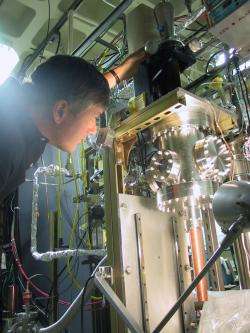Catch and Release: Fishing for Barium Ions

How do you identify the rare thing you're looking for in a vast sea? Go fishing.
Researchers on the Enriched Xenon Observatory (EXO) project, including a group from SLAC, are currently developing ways to catch barium ion "fish" from inside a multi-ton vessel of liquid. They then remove the ions from the liquid and release them from the fishing pole so they can be identified as barium.
A barium-136 ion is the unmistakable sign that somewhere in the sea of xenon-136, a xenon atom underwent radioactive decay. If the two electrons released from that decay have a particular energy, scientists will have hooked the proof that neutrinos are their own anti-particle—an exciting but unproven idea. The observation will also give EXO a way to measure the scanty mass of neutrinos.
The radioactive decay normally emits two neutrinos as well, yet ironically, finding a decay with no neutrinos is what will tell scientists that neutrinos and anti-neutrinos are the same thing. In "neutrinoless double beta decay," the electrons carry all the decay energy otherwise shared with the neutrinos.
Fishing for barium will help the experiment separate the real fish from spurious fish—electrons in the right energy range that come from other sources, such as natural radioactivity and cosmic rays.
After a xenon decay, "the barium ion is sitting there. It hardly moves, so you have to go fish it out," said EXO physicist Peter Rowson.
SLAC has already demonstrated that an electrostatic probe—a small metal fishing pole—can pick up ions from xenon liquid. The probe's electric field attracts positively charged ions. R&D now centers on how to unhook the barium ion from the probe, so it can be identified by a laser system developed by Stanford University, which leads the EXO collaboration. The SLAC group has developed one approach, a cryogenically cooled probe.
"When the probe is dipped in the liquid, xenon ice forms and the ion gets trapped on ice. We pull the probe out, let it thaw and release the ion," said Rowson.
Just don't try it on real fish.
Source: by Heather Rock Woods, Stanford Linear Accelerator Center





















